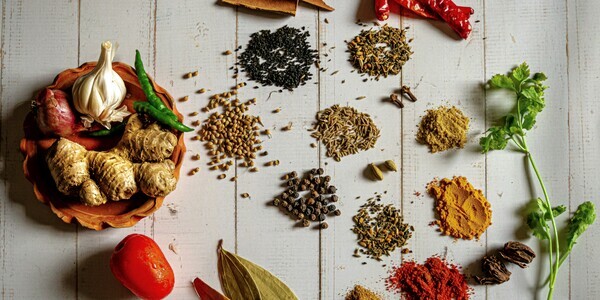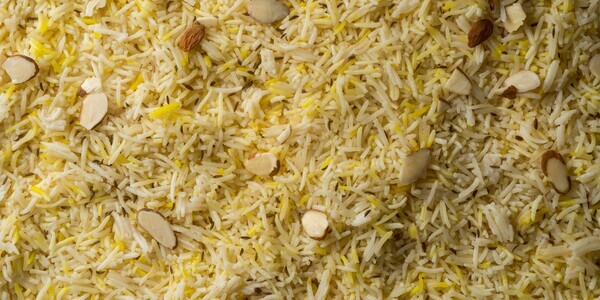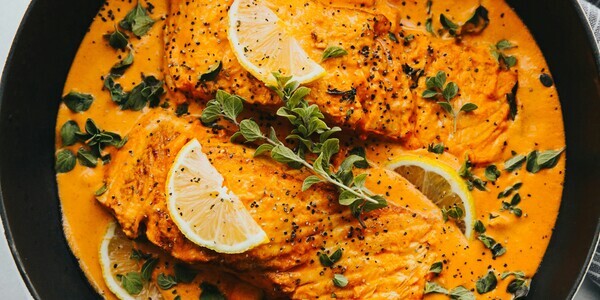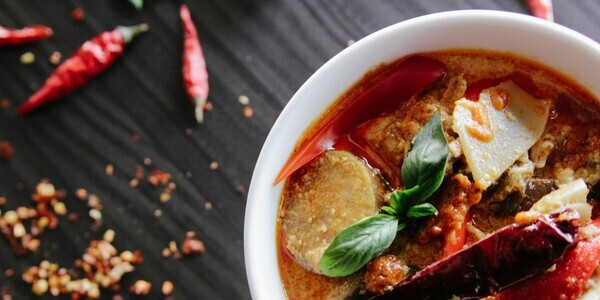A Comprehensive Guide to Wine & Curry
A Comprehensive Guide to Wine & Curry
What wines go with which curries?
Pairing wine with curry is one of the more intriguing exercises in food and wine matching. And one of the more challenging ones. This is because curry’s complex spice blends, fiery heat and rich sauces often require more detailed considerations than when sitting down to pasta, grilled meats, pizza or most traditional European fare. But with curry and spice, get the wrong wine and all can feel flattened, or worse, unpleasantly bitter and astringent.
Get it right, however, and you’ll find the exotic aromatics, subtle sweetness and/or generous fruitiness in the wine can soothe chilli heat, lift fragrant spice, and create a harmony that’s every bit as satisfying as your favourite claret ‘n’ steak partnership.
So, let’s take a dish-by-dish look at some of our most popular curries – from chicken tikka masala to lamb vindaloo – and consider what’s best with what. And why.

First, a few pairing principles
If you’ve read through our Wine & Food Pairing Guide, you’ll know the few rules of thumb to remember when taking on what fiery assaults certain dishes will pose.
Here, contrast and ‘palate cushioning’ are key. Big, tannic reds with high ABV% and heavy oak are out. They’ll wrestle with spice, which in turn will serve only to amplify these traits, leaving you with a bitter, astringent taste.
Instead, stick with whites. Particularly with ones having these traits:
Off-dryness – A subtle sweetness in wine that’s ideal for absorbing and soothing chilli heat. In wine-speak, this is known as ‘residual sugar’, which is achieved when a wine’s fermentation process is for stylistic purposes intentionally cut short. By preventing the process from reaching full dryness, a certain level of sugar – i.e. sweetness – is thus preserved.
Exotic aromatics – to mirror spice complexity.
Lush, youthful fruitiness – to meet intensity without overpowering it.
From Alsatian gewurztraminer and demi-sec Vouvray to aromatic viognier and versatile grüner veltliner, these styles have the perfume, texture and balance to match curry’s flavour spectrum.
*If there must be red, however, ensure tannins are low and fruit is high. Beaujolais, Loire cabaret franc, fruity pinot noir and merlot all fit this bill well.
Wine Matches for Popular Curries
Chicken Tikka Masala
Our unofficial, national dish. One that is creamy, tomato-based, gently spiced, with a touch of sweetness. Go for ripe, rounded fruit to meet the creaminess and enough acidity to cut through the sauce.

Best matches:
Viognier or viognier-marsanne blends from the southern Rhône – floral, peachy, and ample-bodied. Good, stone-fruity cushion for the palate here when extra chillies get chucked into the mix.
Demi-sec Vouvray – off-dry chenin blanc with apple, honey and citrus tones to match the sauce’s sweetness – sweetness to also counterbalance the aforementioned heat.
Alsatian Pinot Gris – lush, aromatic, with gentle spice and generous fruit.
Balti
Although technically speaking the name refers to the metal bowl-shaped vessel in which it is prepared, ‘balti’ otherwise means a lighter tomato-based curry, often with fresh coriander and more pronounced spice than tikka masala. The dish’s freshness calls for something crisp but still aromatic.
Best matches:
Grüner Veltliner – bright acidity, citrus and white pepper complement the spices.
Alsatian Riesling – dry or off-dry, with lime and floral notes resonate with the aromatic spices whilst its depth of fruit stands up to heat well.
Sauvignon Blanc (Sancerre, Pouilly-Fumé, Touraine or New Zealand) – for a more vibrant citrus zip and herbal lift.
Jalfrezi
A restaurant staple that is usually medium to decently spicy. Here, lots of stir-fried peppers, onions and a good presence of chilli, for which an off-dry white is always well equipped.
Best matches:
Gewurztraminer – the ultimate curry wine: exotic rose, lychee and spice notes, oily texture, and a hint of sweetness.
Demi-sec Vouvray – rounded enough to soothe chilli heat, with chenin blanc’s naturally high acidity being ideal for cutting through ghee’s oiliness.
Madras & Vindaloo
The inferno, where your best insulation is ripe, ripe layers of exotic fruit – where a touch of residual sugar provides ever more salvation.
Rich, full-bodied, fiery, and often heady with chilli and spice, Madras has deep tomato and tamarind tang, where vindaloo layers searing chilli heat over vinegar-sharp notes..
Best matches:
Gewurztraminer – best bet, whose bold aromatics stand tall, and where the varietal’s naturally oily texture proves the perfect match for both dishes’ inherent richness.
Off-dry riesling – particularly Kiwi or Alsatian styles, whose power and depth of fruit, citrus lift and balancing sweetness provide an appealing harmony.
If you must go red: Low-tannin, juicy Beaujolais, grenache, or a fruity merlot – even better when slightly chilled for softening the heat.
Lamb Rogan Josh
Fragrant rather than fiery, with deep tomato and onion sweetness and slow-cooked richness. If there’s a curry recipe out there with more margin for red, then this is it. But again, keep it light, keep it super fruity.

Best matches:
Beaujolais/Pinot Noir (light-bodied, fruit-forward) – Saint-Amour, Burgundy, New Zealand.
Grenache – Spain, Languedoc/Roussillon, southern Rhône. Soft tannins, ripe, juicy red fruit, and spice.
Alsatian Pinot Gris, Pinot Blanc, Riesling – aromatic, rounded and able to match lamb’s richness, where good acidity meets at the dish’s tomato core.
Biryani
Not a proper curry, you could say, but a spiced rice dish layered with aromatic herbs and (usually) tender chicken. And because the spice here is comparatively light and the basmati rice fragrant, there’s more room for options. But ensure they all have good freshness.

Best matches:
Grüner Veltliner – the No. 1 option, whose white pepper and lime zest aromas, juicy, lime and red grapefruit palate and zingy acidity fit like a glove around aromatic rice dishes.
Chablis – with sufficient fruit depth and always great freshness, minerality and zip, here is cool-climate chardonnay pairing quite nicely.
New Zealand sauvignon blanc – the more exotic-fruit end of the spectrum that is typical of Kiwi sauvignon (yet always with great freshness and vibrancy) makes this a rather harmonious option.
Bordeaux Blanc – the added component of sémillon to what is otherwise 100% sauvignon blanc adds a lovely bit of texture and just enough weight to really engage the spice and fragrance of biryanis.
Dry Riesling – as with the above, an invigorating resonance.
Provençal Rosé – fruity, dry and refreshing – stick with Provence.
Korma
Creamy, mild, nutty and sweet – the wine should be as opulently weighted, fruity, spicy, and rounded as the dish itself.
Best matches:
Viognier – full-bodied, richly textured, ripe stone fruit, honeysuckle, orange blossom and a subtle almond nuttiness put this on the top of korma’s podium.
Pinot Gris – or dry; as with the above, perfectly weighty, aromatic and fruity.
Demi-sec Vouvray – honeyed and rounded, whose vibrant acidity provides a deft balancing act for korma’s creaminess.
Southern Indian / Sri Lankan Fish Curries
Fragrant, creamy, often with mustard seeds, fresh coriander, curry leaves and tamarind – and lots of fresh, green and red chillies. And because coconut milk so often constitutes a recipe’s base, this calls for a wine with weight but good freshness.

Best matches:
Alsatian whites – exotic fruit, weighty texture, good acidity.
Viognier/white southern Rhône blends – well weighted, richly textured with exotic, spicy fruit. especially
Grüner Veltliner – always the all-rounder for Asian spice: fragrant, peppery, rich, lime-zest palate, good acidity and depth of fruit for beating the heat.
Thai Red and Green Curries
As in the south of India and in Sri Lanka, coconut milk here features heavily. Which, again, means your wines should weigh-in similarly. And with the fragrant lemongrass, galangal, kaffir lime, and varying levels of chilli heat that also come into play so regularly, aromatics, severe fruitiness – if not some off-dryness – is required. So, it’s an equally delectable bet to stick with what’s prescribed in the previous section.

Best matches:
Gewurztraminer – lush fruit and spice to match aromatics.
Off-dry Riesling – citrus freshness meets tropical undertones.
Alsatian whites – as above, all main white varietals have the texture, exotic fruit and padding to take up Thai coconut richness and heat.
Wine guidance with Mr.Wheeler
At this point, you’ll have noticed much overlapping of wines across the combinations as prescribed above. But again, Asian spice must be approached with pairing principles in mind – principles we’ve set down here. Now that you're more familiar with them, you can experiment with any alternatives having these or similar attributes.
Which could mean subbing that Kiwi sauvignon with a vibrant, fruity, Spanish albariño or tropical Rioja Blanco. Or, indeed, that Vouvray for a ripe, peachy, pineappley, honeysuckle-floral chenin blanc from South Africa.
Whatever your discoveries, stick to our guide and you’ll find much drinking and culinary pleasure. As you will by consulting any of our guides. Find them here – maximise your wine experience there.
-- David Adamick, Mr.Wheeler Wine
